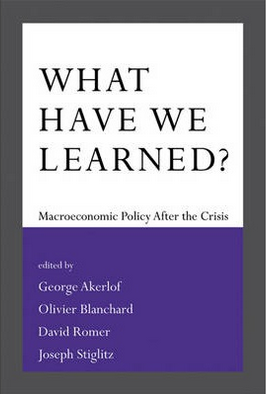
What Have We Learned?: Macroeconomic Policy After the Crisis
[Book Description]
Since 2008, economic policymakers and researchers have occupied a brave new economic world. Previous consensuses have been upended, former assumptions have been cast into doubt, and new approaches have yet to stand the test of time. Policymakers have been forced to improvise and researchers to rethink basic theory. George Akerlof, Nobel Laureate and one of this volume's editors, compares the crisis to a cat stuck in a tree, afraid to move. In April 2013, the International Monetary Fund brought together leading economists and economic policymakers to discuss the slowly emerging contours of the macroeconomic future. This book offers their combined insights. The editors and contributors--who include the Nobel Laureate and bestselling author Joseph Stiglitz, Federal Reserve Vice Chair Janet Yellen, and the former Governor of the Bank of Israel Stanley Fischer--consider the lessons learned from the crisis and its aftermath.They discuss, among other things, post-crisis questions about the traditional policy focus on inflation; macroprudential tools (which focus on the stability of the entire financial system rather than of individual firms) and their effectiveness; fiscal stimulus, public debt, and fiscal consolidation; and exchange rate arrangements.
[Table of Contents]
Introduction: Rethinking Macro Policy 1 (30)
II---Getting Granular
Olivier Blanchard
Giovanni Dell' Ariccia
Paolo Mauro
Part I Monetary Policy
1 Many Targets, Many Instruments: Where Do 31 (6)
We Stand?
Janet L. Yellen
2 Monetary Policy, the Only Game in Town? 37 (8)
Lorenzo Bini Smaghi
3 Monetary Policy during the Crisis: From 45 (10)
the Depths to the Heights
Mervyn A. King
4 Monetary Policy Targets after the Crisis 55 (10)
Michael Woodford
Part II Macroprudential Policy
5 Macroprudential Policy in Prospect 65 (6)
Andrew Haldane
6 Macroprudential Policy and the Financial 71 (16)
Cycle: Some Stylized Facts and Policy
Suggestions
Claudio Borio
7 Macroprudential Policy in Action: Israel 87 (12)
Stanley Fischer
8 Korea's Experiences with Macroprudential 99 (30)
Policy
Choongsoo Kim
Part III Financial Regulation
9 Everything the IMF Wanted to Know about 129(6)
Financial Regulation and Wasn't Afraid to
Ask
Sheila Bair
10 Regulating Large Financial Institutions 135(8)
Jeremy C. Stein
11 The Contours of Banking and the Future 143(12)
of Its Regulation
Jean Tirole
12 Banking Reform in Britain and Europe 155(10)
John Vickers
13 Leverage, Financial Stability, and 165(14)
Deflation
Adair Turner
Part IV Fiscal Policy
14 Defining the Reemerging Role of Fiscal 179(4)
Policy
Janice Eberly
15 Fiscal Policy in the Shadow of Debt: 183(10)
Surplus Keynesianism Still Works
Anders Borg
16 Fiscal Policies in Recessions 193(16)
Roberto Perotti
17 Fiscal Policy 209(16)
Nouriel Roubini
Part V Exchange Rate Arrangements
18 How to Choose an Exchange Rate 225(4)
Arrangement
Agustin Carstens
19 Rethinking Exchange Rate Regimes after 229(16)
the Crisis
Jay C. Shambaugh
20 Exchange Rate Arrangements: Spain and 245(12)
the United Kingdom
Martin Wolf
21 Exchange Rate Arrangements: The Flexible 257(8)
and Fixed Exchange Rate Debate Revisited
Gang Yi
Part VI Capital Account Management
22 Capital Account Management: Toward a New 265(6)
Consensus?
Duvvuri Subbarao
23 Capital Flows and Capital Account 271(18)
Management
Jose De Gregorio
24 Managing Capital Inflows in Brazil 289(18)
Marcio Holland
25 Capital Account Management 307(10)
Helene Rey
Part VII Conclusions
26 The Cat in the Tree and Further 317(4)
Observations: Rethinking Macroeconomic
Policy II
George A. Akerlof
27 Rethinking Macroeconomic Policy 321(6)
Olivier Blanchard
28 Preventing the Next Catastrophe: Where 327(8)
Do We Stand?
David Romer
29 The Lessons of the North Atlantic Crisis 335(14)
for Economic Theory and Policy
Joseph E. Stiglitz
Contributors 349(2)
Index 351

 新书报道
新书报道